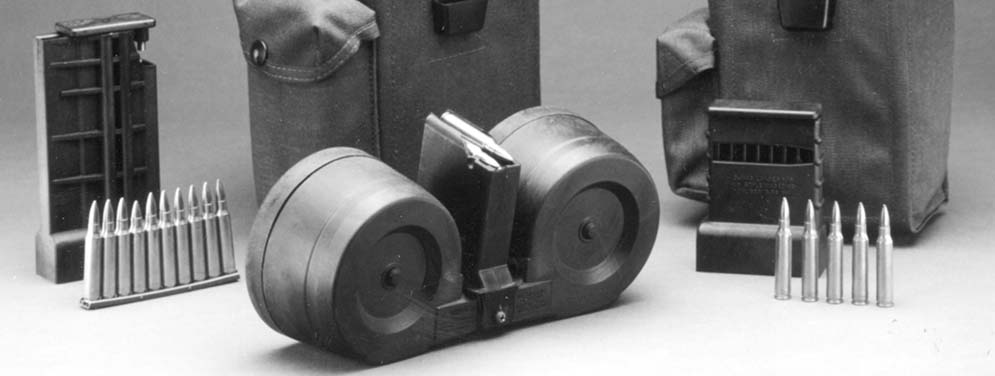By Steve Baughman
This writer recently visited The Beta Company to see, first hand, what goes into making one of the most interesting firearms accessories for the modern battle rifle. Currently available only to military and law enforcement agencies, the C-MAG is gaining world wide recognition as a reliable alternative to belt fed machine guns and traditional magazines. Class III enthusiasts who are fortunate enough to find (or afford) a pre-ban C-MAG should consider themselves lucky…
The C-MAG is manufactured by the Beta Company in Atlanta, Georgia. With the C-MAG, military forces, law enforcement tactical units, and NFA/Class III enthusiasts, are equipped with a magazine capable of delivering 100 rounds of 5.56mm ammunition. The design incorporates twin drums made of lightweight, impact resistant, thermoplastic materials. Live rounds are aligned internally in double rows along the outside walls of the twin drums. To assist feeding reliability, several “spacer” rounds follow the last live round inside each drum. A major difference between the C-MAG and traditional drum magazines is the use of a non-compressed, low-torsion spring. This allows unlimited pre-loaded storage of ammunition, without the risk of wearing out the internal spring. This excellent feature permits the magazine to be prepositioned and stored in arsenals, depots, or support vehicles for rapid deployment. The unloaded magazine weight is 2.2 lbs. The weight, loaded with 100 rounds of M193 ammo, is around 5 lbs. The feed clip (center stack) is interchangeable for different weapon systems or for replacement if damaged. Feed clips are available for the Colt M16 series, Diemaco C7/C8, Royal Ordnance SA80, Beretta AR70/90, Steyr AUG, FNC, FN Minimi/M249 SAW, and the new HK G36. Due to limited demand, only prototype feed clips are available for the Giat FAMAS, SIG SG-50, H&K33, and Galil at this time. A complete “C-MAG system” consists of the dual drum magazine, a choice of loaders, and a carrying pouch.
Company History/Early Development Issues
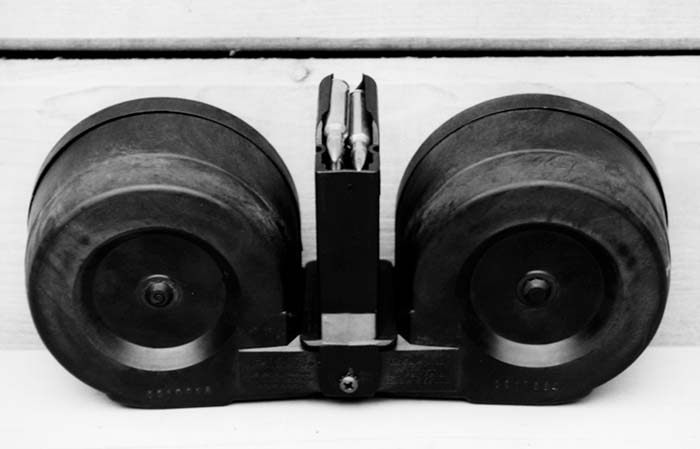
The Beta company came into existence in 1983, and has always been based in Atlanta, Georgia. Jim Sullivan is the original inventor of the C-MAG. His name is usually associated with Eugene Stoner, as they worked together on the development of the Armalite rifles. Mr. Sullivan worked with the Beta company as a consultant in the early development stages of the C-MAG. Dan Shea’s excellent “Stoner Chronicles” in MGN covered much of the early years of firearms development by Stoner and Sullivan.
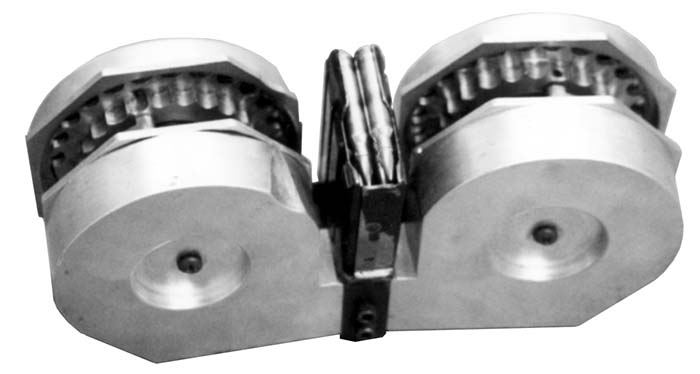
Many companies have tried to develop and produce a reliable drum magazine for the M-16 series of rifles. Metal magazines were too heavy for practical usage. With the advances in plastics materials technology, and with the ability to keep tight tolerances, the C-MAG finally developed into truly reliable mechanism. It had to be made to fit both early and late model M-16s. The center feed clip angles, materials, and tolerances had to be just right to allow proper functioning. Beta engineers determined early on that guns originally designed for plastic magazines were much easier to make reliable feeding devices for. Many gyrations of design and testing were required before a product suitable for military usage was finally perfected. Many variations and options have been investigated. These include clear back covers, last-shot hold open, and others. All these investigations have concluded that the current offering provides the best overall reliability under adverse conditions. Constant feedback from the military units who use the C-MAG keeps Beta informed as to any problems encountered in the field.
Testing Specifications
Although not indestructible, all Beta C-MAG’s are built to international military production standards, and meet or exceed all NATO Mil-Spec tests. Field testing has included continued exposure to temperatures ranging from -40F to +160F. The magazine has proven to function perfectly with ice forming on the exterior, or after submersion in mud and sand. The mags are also resistant to salt water, fuels and a number of chemicals. The C-MAG is in use by all of the U.S. military services, and in many foreign countries. It has seen combat during Desert Storm by 82nd Airborne and Special Forces personnel. The magazine performed well in the desert environment as long as proper gun handling procedures were observed (bolts and dust covers kept closed). Beta is so confident with their product that they do not recommend any spare parts be carried, with the exception of a dust cover (because they are easily lost) and a few spacer rounds (because military units frequently disassemble the magazine and occasionally lose these too). Law enforcement users would normally not require that any spare parts be stocked.
Personal Performance Testing
Reliability of the C-MAG was 100% when good quality ammunition was used in our tests. Our test guns included a full auto Bushmaster/Sendra M-4 carbine, and a Bushmaster V Match AR-15 semi auto. The V Match was set up for varmint hunting, and was topped off with a Tasco Super Sniper SS20X42 scope. The M-4 utilized standard iron sights during our tests. With the assistance of two members of the local Sheriff’s Office Tactical Team members, we ran approximately 500 rounds through the M-4 on full-auto, using the C-MAG with 100% reliability with M193 ammunition. We also fired 100 rounds of reloaded soft point 55gr ammo with no malfunctions. Several hundred rounds of match grade hollow points were also fired with no malfunctions.
Both guns were fired in the prone position, sitting, kneeling, standing, from the hip, and from a bench. The V Match rifle was initially set up for varmint hunting, and with the C-MAG, was turned into the ultimate prairie dog elimination tool. The low profile of the magazine is definitely a plus. It makes the rifle easier to manipulate than the standard, 30- round, box magazines. The overall height of the C-MAG is shorter than a standard 20 round magazine for the M-16 rifle. The only complaint I had was the fact that it is not designed to hold the bolt open after the last shot like a conventional mag, but with 100 rounds of available firepower, I can’t really complain. Some very minor chipping of material was noted on the front of the feed clip due to the speed loading process. The front point of the projectile was responsible for scraping away some of the plastic during loading, although this caused no functioning problems.
When loaded to full capacity for extended periods, the use of a sling system that permits waist level carry is recommended. The extra weight of the total package is enough to warrant a sling system such as this. If required for military purposes, it appeared that a single individual could carry two fully loaded magazines (plus one in the rifle) for a total of 300 rounds. This is probably overkill for most law enforcement scenarios, but the cops involved in last year’s infamous LA bank robbery/shootout might think otherwise. Although two well- placed shots would have stopped that unfortunate chain of events, it appears that certain situations might call for extreme firepower.
The balance of the firearm was not a problem experienced during our firing exercises. The M-4 with a loaded C-MAG balances perfectly when handling the gun with the upper receiver carry handle. If the drum is used on an Aug or similar bullpup type of firearm, the rearward weight might bother some. On the M-4 carbine, the C-MAG was definitely a showstopper on the firing line. All who shot it were impressed. Those with heavy trigger fingers should monitor excessive barrel heat build-up, and adjust fire rates accordingly. Non-Colt or Bushmaster rifles that utilize stainless steel barrels might be at greater meltdown risks, due to a lack of chrome lining in barrel bores. I would go with mil-spec 4140 or 4150 chrome moly barrels for extended use. Barrel fluting for better heat dissipation might be of benefit in these cases. The overall consensus was that the C-MAG was the perfect accessory for the M-4 carbine.
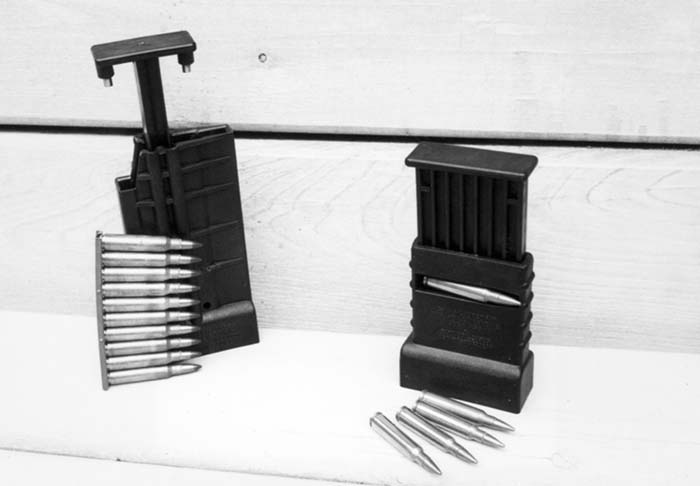
Loading Options
The conventional speed loader system on stripper-clipped ammo for 20 and 30 round standard M-16 magazines will not work with the C-MAG. I tried to use this method and could only get about 3 rounds into the mag. The plastic follower device is just too flimsy to work.
10 Round Speed Loader: The speed loader uses 5.56 ammo that is already loaded on 10 round stripper clips. The speed loader consists of a very sturdy housing which fits over the feed clip of the drum. It uses a plunger to push the rounds off the stripper clips and into the drum. A magnet is attached to the plunger which removes the empty stripper clip from the drum after ammo is loaded. Using this tool is the fastest way to load up the drum. In the hands of an experienced loader, the magazine can be loaded in about 25 seconds using this method.
5 Round Personal Loader: The personal loader uses 5.56 ammo that is loose. This loader consists of a very sturdy housing assembly which fits over the feed clip just like the speed loader. A plunger is used to push 5 loose rounds into the mag. The rounds are loaded into the side opening of the housing while the plunger is pulled up and out of the way.
Hand Loader: You know what this one is. It produces what some call the “Beta thumb”. One round at a time can be pushed into the mag by hand. This is obviously the slowest method unless you really get good at it. Thick callouses on finger and thumb surfaces are very helpful. Feed pressure remains virtually the same throughout the loading process. However, the first 15 rounds are slightly harder to load due to the curvature/bend at the bottom of the magazine.
Maintenance
The C-MAG is a very rugged device which, for most users, will never need any maintenance at all, or only on very rare occasions. During our performance tests, the only thing we needed to do was to wipe gun oil off the outside of the feed clip with a rag after a shooting session. For the users convenience, a technical manual is included which covers cleaning, disassembly, troubleshooting, maintenance, disassembly, operation, inspection, and parts breakdown. The following summarizes some of the technical manuals information related to operation of the C-MAG:
Cleaning: Recommended procedures for cleaning the C-MAG are as follows when these various conditions are encountered:
Harsh sand, dirt, etc.: Remove with cloth or compressed air. Heavier deposits may require water flushing.
Fine sand, silt, mud, etc.: Soak in water with detergent (optional) to saturate and dissolve deposits. Wipe and shake as necessary to aid in removal. Flush with clean water.
Oils, grease, solvents, fuels (gas/diesel): Remove as much as possible by wiping, then soak or flush with solvent. Use acetone or alcohol. Do not use oily fuels such as diesel, mineral spirits, or kerosene. Wash with detergent and water. Rinse with water to remove solvent and detergent residue.
Corroded ammunition and/or corrosion deposits from corroded ammunition: Remove live ammunition from magazine as per technical manual, and clean the same as oil and grease contamination.
Salt deposits from sea water: Light deposits may be removed by soaking in clean water to dissolve the salt residue. Assemblies with heavier deposits should be returned to the manufacturer for repair.
Lubrication: The C-MAG uses only dry lubricant (graphite) on the inner walls of the drum, covers, and center holes of drive gears. Never use any grease, oil, or other fluid-based lubricants.
Inspection: The feed clip (center stack) should be periodically inspected for cracks and chips. Cracks can occur at upper corners, but may not cause immediate failures. Feed clips which are found to have cracks should be replaced. Excessive chipping (missing material) resulting from loading ammunition should result in feed clip replacement.
Troubleshooting
Loading stops after about 40 rounds; loading is unusually difficult; feed is erratic: These symptoms are all characteristics of a dirty magazine. Disassemble and clean as directed. If not dirty, inspect component parts for damage. May also be symptomatic of dirty or corroded ammunition.
Double feeds in weapon; two rounds, or one round and a casing in upper receiver: Feed clip may be cracked on one side allowing rounds to eject spontaneously.
Live rounds mixed with spacer rounds in feed clip below last round link assembly: One drum hesitated feeding. Drum assembly should be cleaned and inspected.
Magazine will not stay in weapon receiver: The magazine may not be fully seated. The magazine latch in feed clip could be damaged – replace feed clip.
Weapon fires several rounds then jams; magazine feeds ok by hand when out of the weapon: Check for secure attachment between the feed clip and drum assembly. Tighten screws if necessary.
Magazine rattles when empty or full: This is normal. The rattle disappears when mag contains less than about 20 rounds.
Adaptation for Firing Blank Rounds
The C-MAG can be used with blank rounds, although the feed clip and related components must be exchanged with an adapter kit. Usually only sold to military units, the kit can be installed by the operator, or it can be returned to Beta for a no-cost conversion. The kit is designed for use with M200 blank rounds. This would be the way to go for certain tactical training and/or theatrical events.
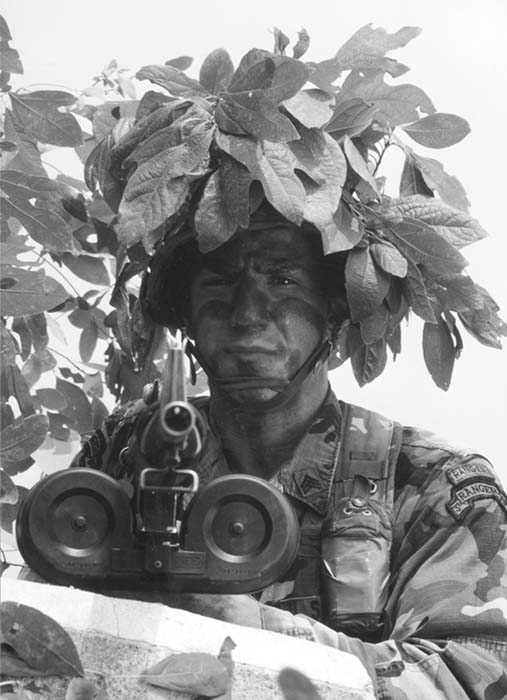
Price
The Beta Company’s policy has always been to sell only to law enforcement, or to military users. Some units which were manufactured prior to the high-capacity magazine ban have made their way into the civilian market through various dealers. At the time of this writing, pre-ban C-MAG’s were selling for about $650-$750. They are very rare though. A complete C-MAG system (magazine/loader/pouch/dry lube) runs about $210 for government/law enforcement purchase orders. Spare parts are available and are relatively inexpensive. Studies have been conducted which compared the cost of a C-MAG with the standard 30 round magazines used for military duty. Figuring a non-disposable service life of 600 cycles for the C-MAG (60,000 rounds), and the equivalent number of 30 round magazines with a service life of 40 cycles reveals a cost savings of about $150 over the life cycle of one C-MAG.
Conclusions/Future Plans
How about a 9mm C-MAG? You 9mm MP-5 and M-16 shooters will go bonkers over this one. Plans are that they will have one available for law enforcement and military by the end of 1998. Two designs are currently in the testing phase. The MP-5 version will be the first one delivered. This will be followed by the M-16 9mm version. Users who have converted the M-16 5.56 to the 9mm kits available will definitely find this one interesting. There is some 7.62 prototype development work underway, but this will occur in the distant future depending upon demand.
To summarize, law enforcement tactical teams can add this unique accessory to their M-16 rifles. The 9mm version will soon be available for MP-5 users. With the world wide battle rifle trend going to the 5.56mm, the C-MAG designs bring a rugged and reliable option when traveling in harms way. It is the standard by which all magazine feeding devices will be judged by for years to come. As soon as the 9mm version is available, plans are in place for SAR to test one out.
Specifications:
Ammunition:NATO standard 5.56, .223 cal
Capacity: Variable, 1 to 100 rounds
Feed Rate:Can exceed 1300 rds/min
Weight:2.2 lbs. empty – 4.6 lbs. loaded
Storage:Indefinite, loaded
Materials:Impact resistant thermoplastic materials for the main components Corrosion resistant ferrous/non-ferrous materials for minor components
Source:
The Beta Company
2137B Flintstone Drive
Tucker, Georgia 30084
1-800-669-BETA
| This article first appeared in Small Arms Review V1N4 (January 1998) |



